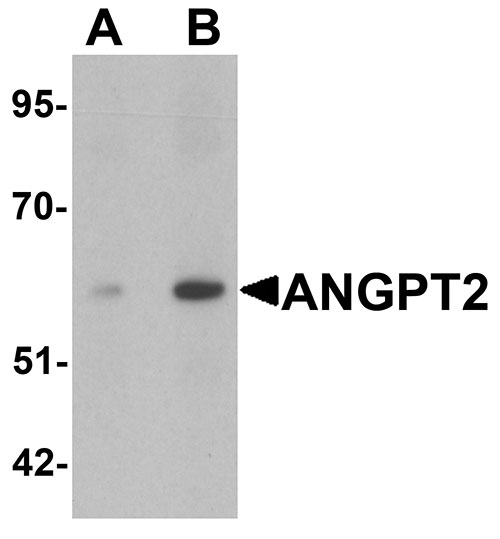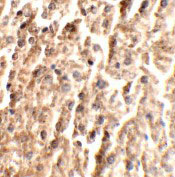ANGPT2 Antibody
- SPECIFICATION
- CITATIONS
- PROTOCOLS
- BACKGROUND

Application
| WB, IHC-P, E |
|---|---|
| Primary Accession | O15123 |
| Other Accession | NP_001138, 4557315 |
| Reactivity | Human, Mouse, Rat |
| Host | Rabbit |
| Clonality | Polyclonal |
| Isotype | IgG |
| Calculated MW | Predicted: 55 kDa Observed: 58 kDa |
| Application Notes | ANGPT2 antibody can be used for detection of ANGPT2 by Western blot at 1 - 2 µg/mL. Antibody can also be used for immunohistochemistry starting at 2.5 µg/mL. |
| Gene ID | 285 |
|---|---|
| Target/Specificity | ANGPT2; At least three isoforms of ANGPT2 are known to exist; this antibody will detect all three isoforms. |
| Reconstitution & Storage | ANGPT2 antibody can be stored at 4℃ for three months and -20℃, stable for up to one year. As with all antibodies care should be taken to avoid repeated freeze thaw cycles. Antibodies should not be exposed to prolonged high temperatures. |
| Precautions | ANGPT2 Antibody is for research use only and not for use in diagnostic or therapeutic procedures. |
| Name | ANGPT2 |
|---|---|
| Function | Binds to TEK/TIE2, competing for the ANGPT1 binding site, and modulating ANGPT1 signaling (PubMed:15284220, PubMed:19116766, PubMed:19223473, PubMed:9204896). Can induce tyrosine phosphorylation of TEK/TIE2 in the absence of ANGPT1 (PubMed:15284220, PubMed:19116766, PubMed:19223473, PubMed:9204896). In the absence of angiogenic inducers, such as VEGF, ANGPT2-mediated loosening of cell-matrix contacts may induce endothelial cell apoptosis with consequent vascular regression. In concert with VEGF, it may facilitate endothelial cell migration and proliferation, thus serving as a permissive angiogenic signal (PubMed:15284220, PubMed:19116766, PubMed:19223473, PubMed:9204896). Involved in the regulation of lymphangiogenesis (PubMed:32908006). |
| Cellular Location | Secreted. |

Thousands of laboratories across the world have published research that depended on the performance of antibodies from Abcepta to advance their research. Check out links to articles that cite our products in major peer-reviewed journals, organized by research category.
info@abcepta.com, and receive a free "I Love Antibodies" mug.
Provided below are standard protocols that you may find useful for product applications.
Background
ANGPT2 Antibody: Angiopoietin-2 (ANGPT2) is a member of the Ang family, a family of angiogenic factors that play major roles in angiogenesis during the development and growth of human cancers, but also during lymphangiogenesis. ANGPT2 is generally considered an antagonist of ANGPT1 and endothelial TEK tyrosine kinase (TIE-2, TEK). ANGPT2 disrupts the vascular remodeling ability of ANGPT1 and is thought to induce endothelial cell apoptosis, resulting in vessel regression. Expression of ANGPT2 has been linked to invasive and metastatic phenotypes of gliomas and other cancers.
References
Hu B and Cheng SY. Angiopoetin-2: Development of inhibitors for cancer therapy. Curr. Oncol. Rep. 2009; 11:111-6.
Maisonpierre PC, Suri C, Jones PF, et al. Angiopoietin-2, a natural antagonist for Tie2 that disrupts in vivo angiogenesis. Science 1997; 277:55-60.
Lobov IB, Brooks PC, Lang RA, et al. Angiopoietin-2 displays VEGF-dependent modulation of capillary structure and endothelial cell survival in vivo. Proc. Natl. Acad. Sci. USA 2002; 99:11205-10.
Bach F, Uddin FJ, Burke D, et al. Angiopoietins in malignancy. Eur. J. Surg. Oncol. 2007; 33:7-15.
If you have used an Abcepta product and would like to share how it has performed, please click on the "Submit Review" button and provide the requested information. Our staff will examine and post your review and contact you if needed.
If you have any additional inquiries please email technical services at tech@abcepta.com.













 Foundational characteristics of cancer include proliferation, angiogenesis, migration, evasion of apoptosis, and cellular immortality. Find key markers for these cellular processes and antibodies to detect them.
Foundational characteristics of cancer include proliferation, angiogenesis, migration, evasion of apoptosis, and cellular immortality. Find key markers for these cellular processes and antibodies to detect them. The SUMOplot™ Analysis Program predicts and scores sumoylation sites in your protein. SUMOylation is a post-translational modification involved in various cellular processes, such as nuclear-cytosolic transport, transcriptional regulation, apoptosis, protein stability, response to stress, and progression through the cell cycle.
The SUMOplot™ Analysis Program predicts and scores sumoylation sites in your protein. SUMOylation is a post-translational modification involved in various cellular processes, such as nuclear-cytosolic transport, transcriptional regulation, apoptosis, protein stability, response to stress, and progression through the cell cycle. The Autophagy Receptor Motif Plotter predicts and scores autophagy receptor binding sites in your protein. Identifying proteins connected to this pathway is critical to understanding the role of autophagy in physiological as well as pathological processes such as development, differentiation, neurodegenerative diseases, stress, infection, and cancer.
The Autophagy Receptor Motif Plotter predicts and scores autophagy receptor binding sites in your protein. Identifying proteins connected to this pathway is critical to understanding the role of autophagy in physiological as well as pathological processes such as development, differentiation, neurodegenerative diseases, stress, infection, and cancer.



